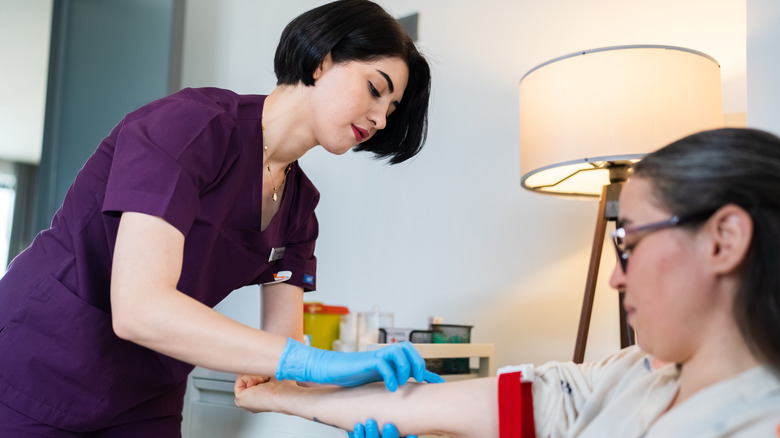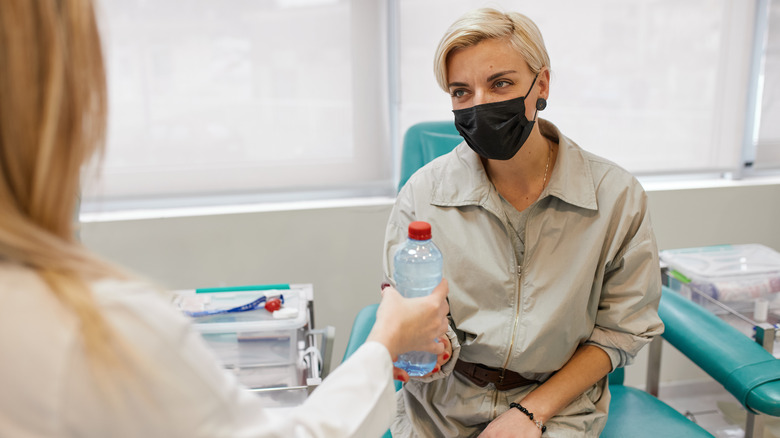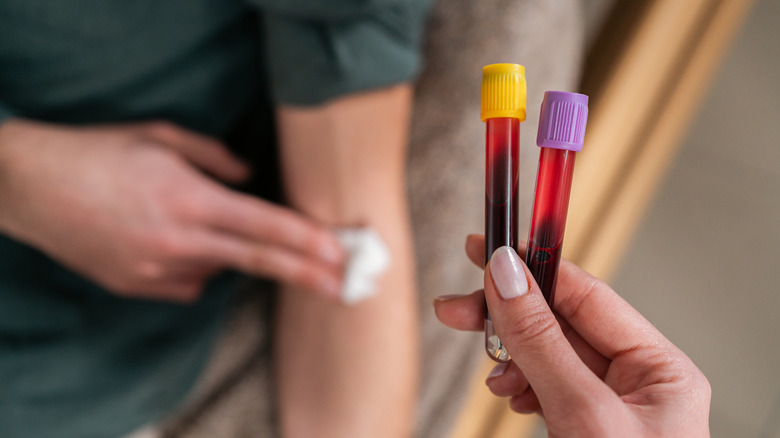Why It's So Hard To Find Your Veins When Getting Blood Drawn
While a blood draw is probably not your favorite activity, for some people, it's pretty quick and painless. Having veins that are easy to find can make the whole process go a lot more smoothly. After all, nobody likes having to get pricked more than once because the target was missed on the first go.
Exactly how much blood will need to be extracted during a blood draw will vary by test. Generally speaking, however, a complete blood count (CBC) may require up to 30 milliliters, according to the Cleveland Clinic. This is the most common type of blood test that most people get during their yearly physical. A CBC can reveal a patient's red blood cell, white blood cell, and platelet count; hemoglobin levels; and much more. Overall, routine blood tests are important in order to continuously monitor our health as we age.
When getting your blood drawn, the phlebotomist will first feel around your inner elbow to detect the best possible vein. This is sometimes also done with the help of a tourniquet, explains e7 Health. However, if you're someone whose veins are notoriously tricky to find when getting blood drawn, you may be wondering what the deal is.
Types of veins and dehydration
One reason why your veins may be harder to find during a blood draw is that they may be naturally smaller in size or situated deeper beneath the skin's surface, according to e7 Health. Similarly, you could also have what's known as rolling veins. True to the name, these veins can be hard to pin down as they tend to roll away from the needle as blood is drawn. If you know this is the case, give your phlebotomist a heads-up at the start of the appointment. They can position their hands in such a way as to help keep your vein in place during the draw, a method otherwise known as anchoring the vein (via PhlebotomyU).
Alternatively, perhaps you're in need of more water. When dehydrated, we are more prone to constricted or collapsed veins, which make them harder to reach. Even if you have been drinking ample amounts of liquid, your beverage of choice may be doing you a disservice if what you've been drinking is coffee or an energy drink. That's because caffeine causes our blood vessels to constrict, or shrink, which makes drawing blood more challenging. This is also the case with nicotine. Therefore, veins may potentially be more difficult to access in patients who smoke.
How to prep your veins for a blood draw
According to 2023 research published in the Harm Reduction Journal, patient intravenous drug use may also increase the risk that there will be difficulty in accessing veins for blood tests. In some cases, this may be due to vein or blood vessel damage. The researchers point out that this can impact a patient's quality of care and that alternative phlebotomy services, such as vein access through an ultrasound device, may be more effective for these patients.
If your veins are difficult to find when getting blood drawn, experts offer some general tips on how you can best ready your veins for a smooth appointment. First, avoid caffeinated beverages and be sure to drink enough water so that your urine appears light yellow in color (via e7 Health). Second, although many doctors' offices can be pretty chilly, try and keep your arms as warm as possible. You can do so by sliding a warm compress along the insides of your arms or running your arms under warm sink water at the start of the appointment (per The Washington Post). In doing so, this can help the veins expand and make them easier to find.



